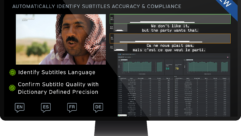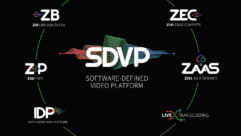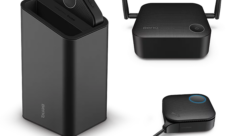
IT Trends: Content Management
Apr 1, 2006 12:00 PM,
By Brent Harshbarger
With changing data flow, flexibility is key to integration.
Back in the ’70s, they put a new identification plaque on the door of one of my favorite rooms at school. Three simple letters, IMC (standing for Instructional Media Center), replaced the name “library.” The IMC was no longer just a place to get books. It now included media items such as round, black vinyl disks called records, albums, or LPs. You could get films, film projectors, and filmstrip. The IMC also had microfiche to look up old magazine articles, and a real card catalog to find all of this cool media.
Today, these devices have been replaced by .mp3, .pdf, .wav, .fla, .wmf, .avi, .ppt, and several other file types that make up our media. It is easier to create, edit, copy, transport, and present content than ever before; in some ways, it is getting easier every day — with the exception of the current state of digital rights management (DRM).
The lines between specific physical media types are becoming more blurred every day. Books are becoming soft: You can download them from the Internet, and newer books include animations for illustrations. The local record shop has almost become extinct because you can search and download music from the Internet. Television networks are now adding their content to the Internet, creating new business models to retain viewers as more and more people shift from a discrete box like a TV to a network-based digital media system. The lines between computer technology and traditional AV have been crossed, and traditional AV is fast disappearing. After all, where would we be without our MP3 players, DVRs, and other digital devices?
The changes in the past five years have been extreme. Has the AV industry kept up? In many ways, no: We tend to think of devices and system management as discrete system components.
Media Retrieval Systems (MRSs) are still largely digital control of a discrete device, and the IMC card catalog is largely still a separate system to the media, meaning you can do a search for the media, but more than likely you still have to physically walk somewhere to get it, or take additional steps to consume it from the search. In a lot of ways, Google is trying to resolve this search issue, but not all archives, libraries, and media centers are open to the public. This is where the AV contractor of today can cultivate new business from current clients and add some new clients through closing the gaps with content management.
MEDIA OR ASSET?
There are two types of content management to consider for this discussion: media management and asset management. Media management deals with content and is defined by the equation content = essence + metadata. Essence represents video, audio, graphics, data, and images, and metadata represents information about the essence. Metadata is where the management information resides. Asset management is defined by the equation asset = content + rights. We have the definition for content already, so that leaves us with rights. Rights are the details of patent, copyright, or intellectual property and its usage.
Educators will be primarily interested in media management; whereas, broadcasters and those with commercial concerns will be interested in asset management. Corporate marketing departments require a significant amount of asset management. They have to manage white papers, brochures, logos, advertising, and a host of other elements from a creation, editing, and distribution standpoint, but they need to archive it for historical and legal reasons, as well. Many corporations are converting their old analog content to digital for the benefits of easy search and retrieval from archive information and assets.
The need to convert analog assets to digital requires ingest stations and modern databases to catalog the information. But these systems must support the growing need for Intranet access to all of the material. Metadata is the key to this solution. Most of the metadata schemes today are based on XML. The two media most popular with our industry are MXF and AAF because they were not only developed by our industry, they also share a common data model.
DRM IN THE REAL WORLD
The Adobe acquisition of Macromedia should provide a great deal of benefit in media and asset management in the future. However, DRM is still somewhat complicated, which should translate into dollars for you from all of the opportunities to resolve these issues for the customer and getting DRM vendors to be more consumer friendly.
Here is an example: I was recently doing some research and needed some information, so I found a book and downloaded the electronic version at my office. I needed to continue working on it at home, so I emailed the PDF to myself to download on my computer at home. However, when I downloaded the file at home, I found it required that I sign into .NET Passport. The only problem was that I had to first authenticate my file via .NET Passport on the computer it was originally downloaded to, which was 30 miles away. You can see that this was going to take more effort than it really should. DRM is very important to the holder of the asset, so we will see more of the technology than less of it. Therefore, as you build media systems or digital media centers for education and corporations, you will need to become very astute to these technologies and their uses. You will need knowledge and tools for DRM systems from Adobe, Microsoft, and Macrovision.
FUTURE INTEGRATION
The opportunity for system integrators is now to do more soft integration — making the media database more usable by providing a means to ingest older technology, cataloging all media into central depository (yet making it flexible for the client to consume it in an interactive way), and keeping assets protected. The basic building blocks for this type of system are ingest stations, database or media/asset management systems, storage, servers, computer networks, and user interfaces. In the education and business world, Smart Boards with projectors are becoming the interface of choice. However, the experience for the user will be determined by how easily media can be searched, accessed, and incorporated with other media.
The trend of moving discrete systems into a single digital media system continues. Simplifying discrete systems into a single digital architecture reduces cabling cost and hardware integration complexity, and provides a more flexible and fluid experience for the user. This can be accomplished by focusing on storage and database technologies built on XML technologies including MFX, AAF, MPEG-7, and MPEG-21, and the related asset management technologies will provide the foundation on which you can build your current and future business.
The equations for media and asset management in this article are courtesy File Interchange Handbook: For images audio and metadata, by Brad Gilmer, editor in chief © Focal Press 2004.










